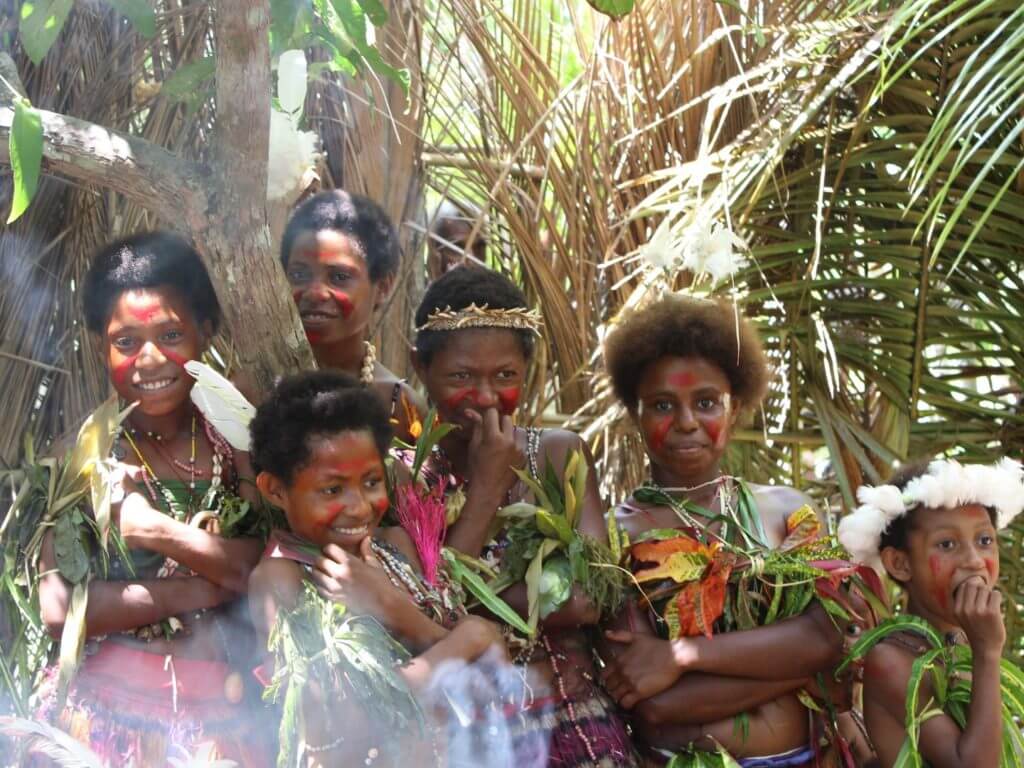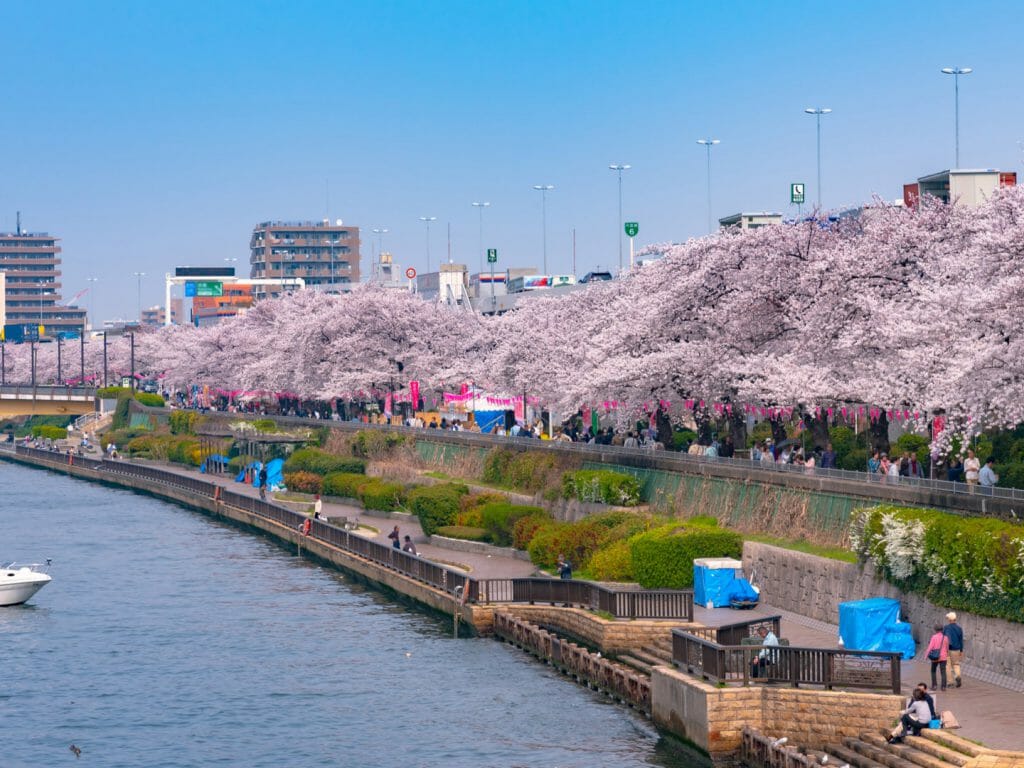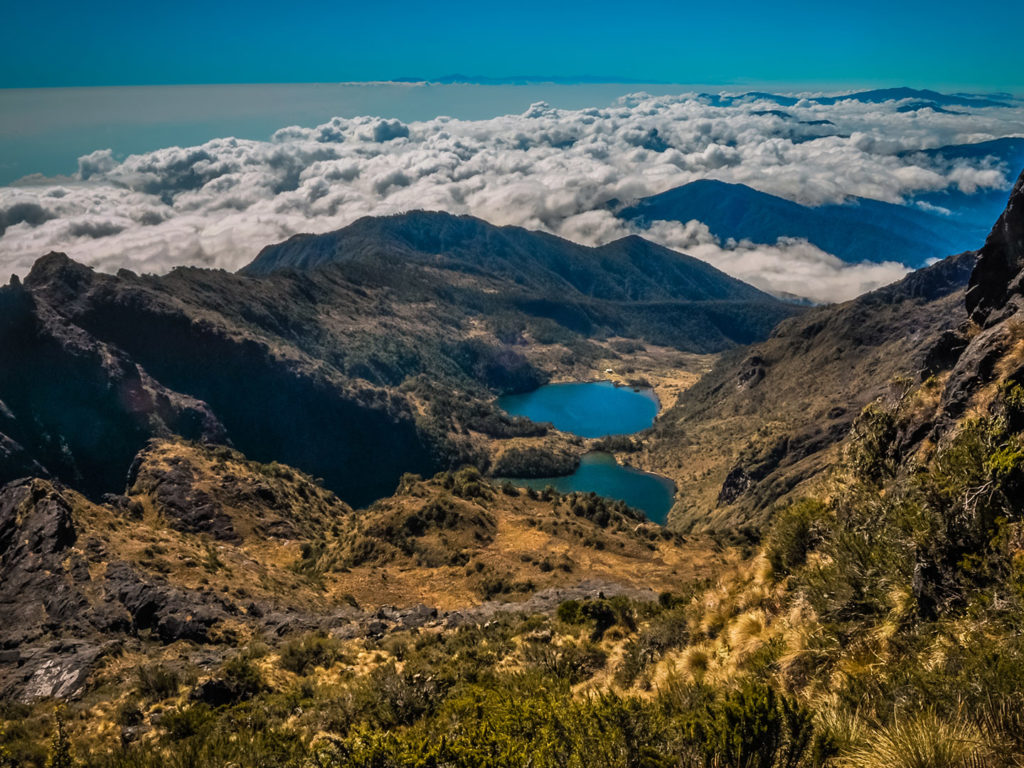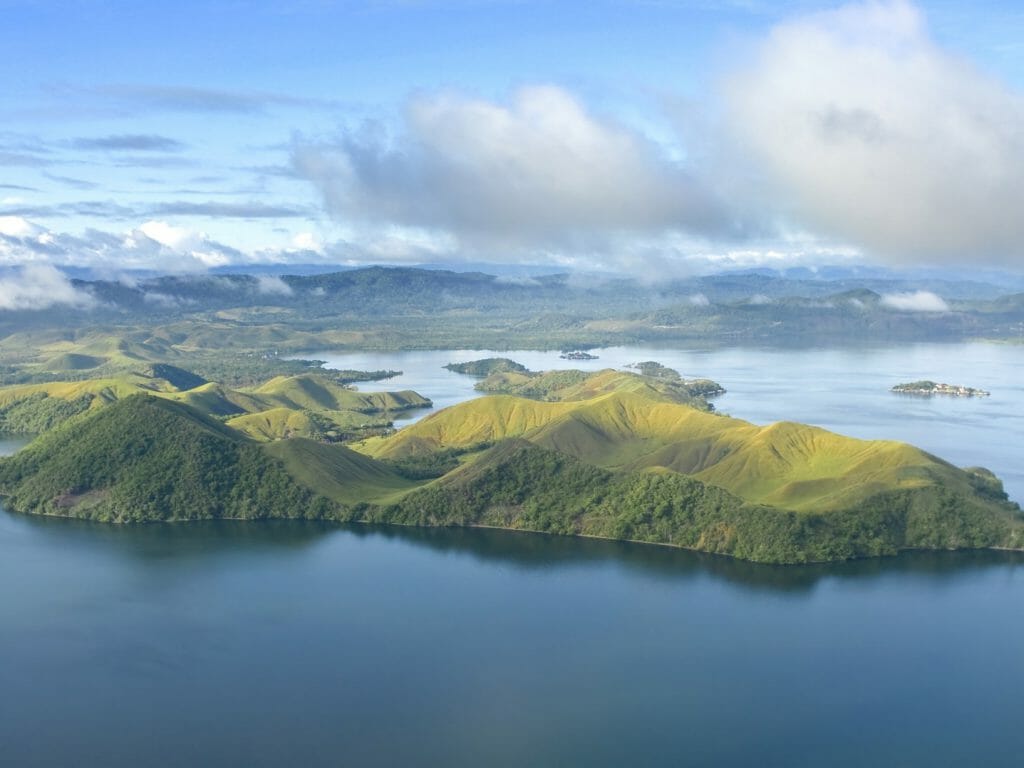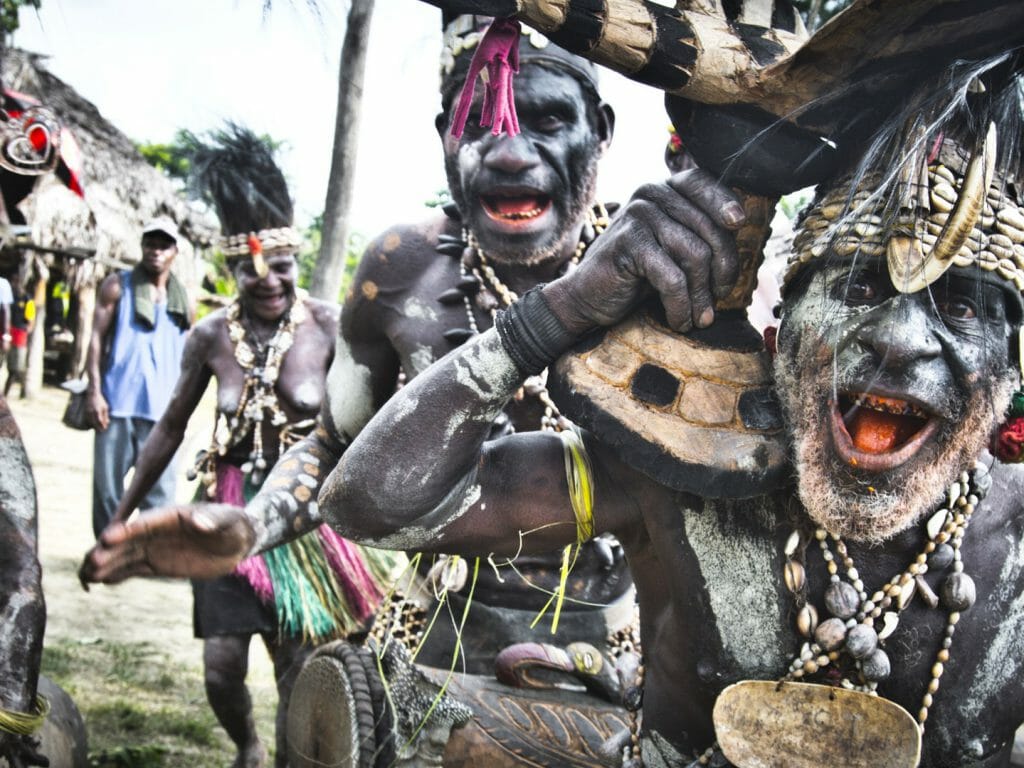“He is a great cutter.”
I stare at him. Is it my imagination or are his features crocodilian?
“What makes a good cutter?”
“He has twenty-five years’ experience. He can cut quickly.”
Looking at the number of vivid welts across the bodies of the young men in the tambaran it was obvious that speed was a key factor in being a good cutter. So too skill and dexterity. Emulating the ridges of the crocodile which they worship, the patterns were intricate. They had a tactile beauty that made me want to reach out and touch the weals tattooed into their skin.
I was in the Middle Sepik, which thanks to its diversity, arts, rituals and ceremonies, is the cultural heart of Papua New Guinea. No mean accolade in a country famed for its tribalism. More than 800 mutually unintelligible languages are spoken in PNG – the highest concentration of languages in the world. They attest to the extraordinary isolation of individual tribes over centuries and the country’s formidable geography – even today there are no roads out of Port Moresby, the capital.
There is little that binds the country together. No real sense of national identity. No road networks. Pidgin, a kind of creole, is the lingua franca that just about enables communication from tribe to tribe via its playful lyricism. Bilum is the word used for the ubiquitous string bag, meri for woman (derived from Mary) but it is the composite phrases for introduced words where pidgin shows its real ingenuity: a helicopter is mix master bilong Jesus Christ and Prince Charles is nambawan pikinini bilong Mises Kwin. For me, such phrases hint at an endearing sense of humour that unites the country.
Our journey, after a brief transit through Port Moresby and internal flight during which the safety briefing asked us not to chew betel, began at Wewak on the north-east coast. From here we were driven inland passing wooden huts on stilts in well-manicured plots – the grass is cut to keep out snakes, reduce mosquitos
and to keep the encroaching fecundity of the forest at bay. The villages were poor but there was not poverty. There was none of the squalor that blights the shanty towns of the cities.
Wherever we stopped people came forward to shake hands. They smiled. There was a warmth, openness and welcome. It is a friendliness that challenges the aggressive stereotypes that prejudice preconceptions of the peoples of Papua. Above all they spoke English, allowing for engagement, a reciprocity that is all too rare in travel today. There was a mutual interest.
We arrived at Pagwi, a frontier trading port where one doesn’t ask too many questions, and headed downstream in a motorised dugout. Sprouting hills, walls of vegetation, banks of papyrus, villages on wooden stilts, palm thatched roofs, children swimming in the water’s edge gave a sense of journey. A feeling of going beyond the ordinary which was confirmed by the simplicity of the rudimentary guesthouse in which we overnighted.
“You are up early this morning,” an old gentleman commented with a smile as we poled through a narrow channel.
“To beat the rush hour.”
Good for you,” he replied with a smile and a laugh. Laughter is a universal and inescapable feature of PNG.
We arrived at Palimbe, a village surrounded by banana and palm trees, a village of 400 people who speak the Yatmul Language and worship the crocodile. The early morning sun bathed the Spirit House, a long thatched building on stilts, in a gentle light. Blood stones, where the heads of enemies were smashed, spoke of a darker, more violent past. The rhythmic visceral drumming of a hollowed-out rain tree announced our arrival. I felt transported back in time. As if an explorer stumbling upon an isolated idyll for the first time.
But I was not. The Japanese were here in 1943 – in the museum in Goroka I was shocked to read that 300,000 Japanese had been in the country during WWII and that 170,000 of them had lost their lives. Missionaries, a pervasive part of PNG, had been here. So too tourists.
None of the above detracted from the charm of Palimbe. Mobile phones and murderous mosquitos, however did. That was until I shook myself out of my naivety and remembered that not only are mobile phones a fact of modern life but that they are bizarrely preserving many local languages in PNG which are now being written for the first time. The mosquitos were less easy to deal with but were only a temporary irritant and certainly no deterrent to what was a most magical visit.
We met Richard who spoke flawless English, having been educated in the Eastern Province. He was born in 1973 and was married in 1997. Two of his children have died.
“What of?”
“My enemies.” An educated man who believes in superstition, a ubiquitous idiosyncrasy of Papua New Guinea.
In the tambaran, spirit house, smoke wafts. Young bearded men – they are not allowed to shave whilst initiates – sit in grey mud and silence, swatting themselves with palm fans. They wear only short skirts of palm leaves – lap lap or more derogatorily, arse grass – that give them a modicum of modesty and leave their buttocks bared. Their pectorals are hardened from years of chopping wood and paddling the waters of the Sepik. Their bodies are articulated by the lines of welts across their bodies, the scarification for which the village is famed.
The cuts are made with a blade, which has replaced the bamboo needle, and then rubbed with the oil of a guat tree to make them blister. Older men – fathers, uncles, relatives – sit on wooden platforms, swinging their legs and observing their charges to ensure that rituals are upheld. This seems odd given that female tourists are allowed into the spirit house, a sign of change and that the tourist dollar is keeping the tradition alive. I have an issue with cultural voyeurism but it does provide a source of much needed income to the villagers. Whatever my doubts, my time in the spirit house with the initiates is both intriguing and compelling.
Further upstream in Wagu we saw the Lesser Bird of Paradise – PNG has 38 of the world’s 41 birds of paradise. Lesser in name but not spectacle. A beautiful bird of maroon-brown with a yellow crown and brownish-yellow back. It is easy to see how their feathers were desired by the women of Europe to decorate their hats in the nineteenth century and that, at its height, this trade in the plumes of birds of paradise reached 100,000 skins a year. A magical sight made all the more special by John’s reaction. John was a young man from Ambunti, a couple of hours downstream by motorised dugout. It was touching to see his smile and wide-eyed, open-mouthed wonder at seeing this bird for the first time. It speaks volumes of the innocence of the people but more importantly the regionalisation of the country as a whole.
We walk through the village which has a laidback charm and sense of civic pride. Here children do as they are told; none of the interminable negotiation that so blights the lives of western parents. We entered a men-only hut on the lakeside, a place for men to come and share stories. It seems at odds with the school on the hill which is teaching gender equality. James, an old man of the dog tribe with a pierced nose and septum, was tending to his net. It no longer happens, piercing that is.
A few hours further upriver in Sawgup we meet another James. This James belongs to the insect tribe and worships the praying mantis, a symbol of strength. He remembers human skulls being kept in the spirit house when he was young. He sees ghosts as lightning. He has travelled to Abergavenny, Wales, as part of a television production on remote tribes.
Both dog James and insect James personify the dichotomy and changing nature of PNG. Whilst remote and little visited, stereotypes of primitive, un-contacted tribes are outmoded. Already by the late 1960s the lowland peoples were no longer wearing traditional dress. Although the peoples of the highlands where, they would only do so for another thirty years, traditional dress having faded out by the turn of the millennia.
On the one hand this makes the action of getting dressed up for tourists as inauthentic. On the other hand the fact that they have the costumes is a different situation. Seeing tribes is the same as seeing the changing of the guard at Buckingham Palace – both are a tradition that is performed for tourism. Indeed some traditions, whether dance or dress, have only survived in areas where there have been tourists.
We travel to the highlands to see the Asaro mudmen, specifically to a village called Geremiake. The plots are fertile, a veritable garden of Eden. Ginger, yam, banana, sweet potato, sugar cane are all grown. For a short time they down the tools of the gardener and put on the attire of performers.
The men cover their bodies in a light grey clay. They shiver with cold. They stand around a fire to warm up and also to dry the clay. Banter and home-rolled cigarettes are shared. They don their masks of mud, homemade and ghoulish. They perform a silent ghostly dance. Afterwards there is laughter, the camaraderie of a shared moment. Inside a hut, I catch a glimpse of two of the dancers taking photos of each other on their mobile phones. It might be staged but it is not contrived.
The dress might have been dropped but many of the traditional beliefs remain. Clothing might change but inwardly nothing has changed – not even the missionaries are able to do this. Superstition is engrained in the national psyche.
The coast off Tufi’s peninsula, or Cape Nelson as it was named by the British, is a place where sea and mountains meet. A paradise accessed only by boat or air. Gnarled green fingers stretch out into the sea creating fjords of hidden surprises – technically they are rais as they were created by volcano as opposed to ice. These rais give the region a very particular fingerprint of turquoise coral bays, surrounded by steep ridges covered in rainforest and kunai grasslands.
In one we swim up to and under a twenty metre waterfall. The water is cold. Refreshingly so. In another we climb up a hillside bursting with bromeliads and vines with the enchanting Molly and meet her elderly mother Wilma who, whilst uncertain of her age, knows that she had her face tattooed when she was fifteen. She knows too that it took a month to tattoo. She remembers how painful it was. Whilst her face bears the scars of the past, her heart does not: she welcomed us with the biggest smile and hug I have had in years. Saying goodbye was not easy.
In a third, I listen to the crash of the surf, the rustling of palm leaves, the whistling of a honey eater and the fluttering of a butterfly. There is much beauty in such simplicity. This is best illustrated by six year old Gary, who, when asked to draw the things that matter most to him, sketches a fish, a tree and a house.
We pass palm trees silhouetted against sunlit clouds and rickety outriggers, the only mode of transport in the region. Vines, as opposed to nails and screws, bind the outriggers together. The only concession to the twenty-first century are the patchwork of materials used in their sails. They are paddled slowly, deliberately, in even strokes. Nothing is rushed. Such is Tufi. It is easy to see why there is only one policeman. So too that he is underemployed.
Unemployment is a problem in PNG, a country whose population has tripled in the last forty years to nine million. It is a country with little employment. Young men head to towns in search of riches but end up being branded as raskols and embroiled in a world of violence. There is an edge to parts of PNG but having been made to feel so welcome and laughed so much you see beyond the bad press – most security issues are largely misplaced and based on the interests of Australian journalists. I could not say the same about the problems of gender inequality.
In short it is not a straightforward country but its complexity is part of its charm. It is a country that I have fallen in love with but not for the reasons I had expected. Maybe the trite tourist board strapline is true after all – the land of the unexpected – and I had only just scratched the surface.


